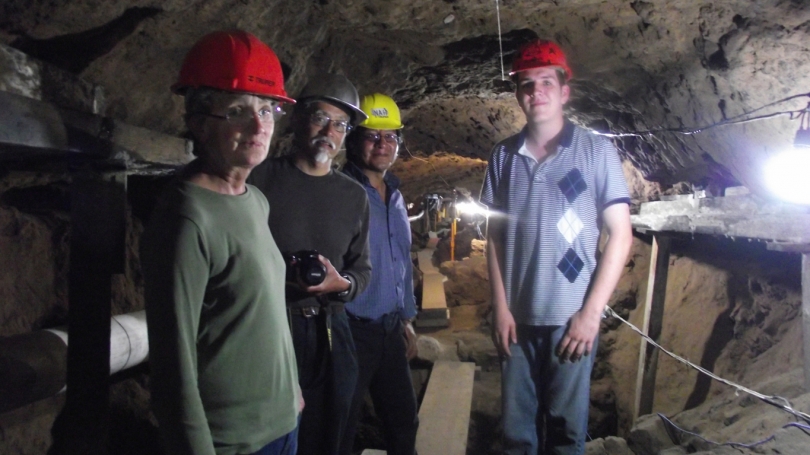The Stamps Scholar Award has allowed Mejía-Ramón, a physics and anthropology double major, to finance a study of the paleohydrology of the Teotihuacán Valley. Teotihuacán is an ancient Mesoamerican city in Mexico that Mejía-Ramón believes thrived agriculturally through its own intricate system of canals. Using satellite imagery and geophysical prospection, Mejía-Ramón has spent the last two years studying the region to locate these canals. He has worked with Deborah Nichols, the William J. Bryant 1925 Professor of Anthropology at Dartmouth, and other faculty from Boston University and the Universidad Nacional Autónoma de México.
Mejía-Ramón, a native of both Naucalpan, Mexico and East Longmeadow, Mass., recently spoke to the Web Services Content Corps Team about his project.
Why does your project matter? How can others benefit from your research?
Justifying it sometimes has been difficult. As with most scientific projects, the benefit may not be immediately visible, or may be more nuanced than people believe. What the public has to understand is that current problems can be solved by looking into the past. You see, my project is not just archaeology, but about ancient hydrology and about ancient agriculture. The valley I am studying had around 150,000 inhabitants, and the land could only support around 30,000. I think it is crucial to understand how they grew their food, not only because it is interesting, but because it can teach us how modern food growing can be improved.
Interesting. Where and how have you conducted your research?
Alongside the Stamps Scholar Award, I worked with Neukom Postdoctoral Fellow, Jason Herrmann, on proposals to the the DigitalGlobe Foundation that awarded grants to me and Professor Nichols, donating the multispectral imagery data. I applied different mathematical and computational methods to bring out nuanced features undetectable with the naked eye. These nuances, I am convinced, are indicative of the presence of canals. In Mexico, I then used ground penetrating radar and other geophysical equipment with the assistance of Luis Barba and Agustín Ortiz Butrón from the National Autonomous University of Mexico (UNAM) to further validate their existence.
Have there been instances in which you were able to bring what you learned outside of the classroom, into the class?
Oh, yes! I have had to deal with a lot of programming, remote sensing, and use models and equipment I had never taken any formal coursework in. I had to learn on my own how to use many of these tools, and then I ended up taking classes in it. It's been a form of feedback process—I do and then I learn. Unconventional, but it works.
This experience has been so important in my growth as an aspiring anthropologist. You have no instructions. You have to think about everything yourself. It is so much more rewarding because you didn’t do something for a grade, but for the sake of it. I went in headfirst, learning how it’s really done versus how it should be done.
What is some advice you would give to an aspiring applicant?
Make sure you like what you want to do. Don’t apply just because you want to do a project and you think this is an easy way to get money, love it. Love what you do. It’s a lot of money and a lot of responsibility. Take a moment before you apply and really reflect on what it is you want to do.
What are your plans for after graduation?
Everything is just happening so quickly. I am off this term and just presented the preliminary results of my project at the 81st annual meeting of the Society for American Archaeology, held in Orlando, FL. Then I’ll be going to Mexico. I'll be back in May to finish my thesis and to receive my diploma. Over the summer, I plan to return to the Basin of Mexico to work in Zumpango with a team from Arizona State University led by Dr. Chris Morehart. Then, if my permission is given, I'll travel to Mexico to excavate the site I have been studying. And then, well, I'm off to graduate school. I am still deciding where, but I know that's my next step.
Mejía-Ramón wanted to stress his gratitude and appreciation for the Stamps Scholar Award for making his dreams a reality. “I am eternally grateful. This opportunity has really set me apart when applying to graduate school—definitely one of the many perks of this program.”
The Project “La Paleohidrología del Valle de Teotihuacan” is funded in part by the Stamps Family Charitable Foundation, the Neukom Institute, the Claire Garber Goodman Foundation, the Lucas Family Fund, and the Dartmouth College Class of 1996. Ortíz Butrón, Barba, and Mejía-Ramón have solicited permission from the Instituto Nacional de Antropología e Historia to excavate the identified features. They would also like to thank the authorities of the Ejido de las Villas de San Juan Teotihuacán y a sus Barrios for their support in this project.
The Penelope W. and E. Roe Stamps IV Leadership Scholar Awards provide undergraduate students an opportunity to create and pursue their own experiential learning project. Each Stamps Scholar receives up to $10,000 over the course of their final two years at Dartmouth. Half of the funds come from Dartmouth, the other half from the Stamps Foundation.
